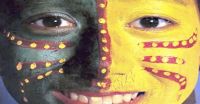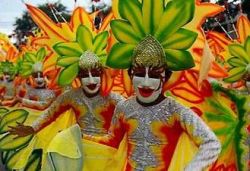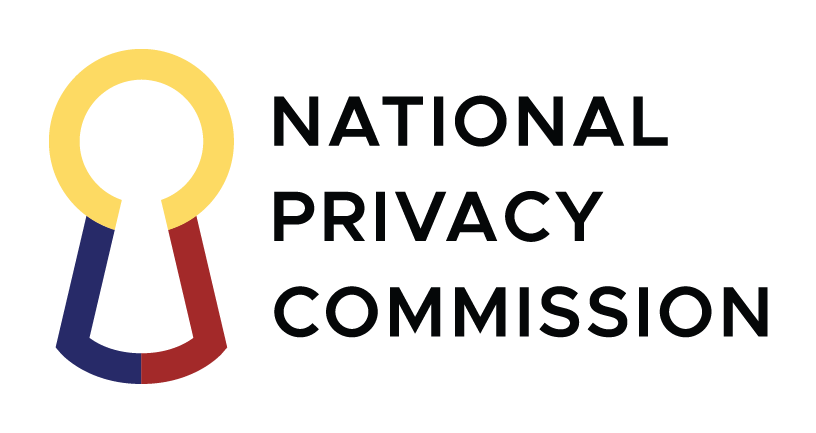|
In 1898, the Philippines became the first and only colony of the United States. Following the Philippine-American War, the United States brought widespread education to the islands. Filipinos fought alongside Americans during World War II, particularly at the famous battle of Bataan and Corregidor which delayed Japanese advance and saved Australia. They then waged a guerilla war against the Japanese from 1941 to 1945. The Philippines regained its independence in 1946. Filipinos are a freedom-loving people, having waged two peaceful, bloodless revolutions against what were perceived as corrupt regimes. The Philippines is a vibrant democracy, as evidenced by 12 English national newspapers, 7 national television stations, hundreds of cable TV stations, and 2,000 radio stations. Filipinos are a fun-loving people. Throughout the islands, there are fiestas celebrated everyday and foreign guests are always welcome to their homes. People and Religion
The Filipino character is actually a little bit of all the cultures put together. The bayanihan or spirit of kinship and camaraderie that Filipinos are famous for is said to be taken from Malay forefathers. The close family relations are said to have been inherited from the Chinese. The piousness comes from the Spaniards who introduced Christianity in the 16th century. Hospitality is a common denominator in the Filipino character and this is what distinguishes the Filipino. Filipinos are probably one of the few, if not the only, English-proficient Oriental people today. Pilipino is the official national language, with English considered as the country's unofficial one.
The country is marked by a true blend of cultures; truly in the Philippines, East meets West. The background of the people is Indonesian and Malay. There are Chinese and Spanish elements as well. The history of American rule and contact with merchants and traders culminated in a unique blend of East and West, both in the appearance and culture of the Filipinos, or people of the Philippines.
Hospitality, a trait displayed by every Filipino, makes these people legendary in Southeast Asia. Seldom can you find such hospitable people who enjoy the company of their Western visitors. Perhaps due to their long association with Spain, Filipinos are emotional and passionate about life in a way that seems more Latin than Asian.
Predominantly Christian. Christianity was introduced as early as the 16th century with the coming of Ferdinand Magellan in 1521. Protestantism was introduced by the first Presbyterian and Methodist missionaries who arrived with the American soldiers in 1899. XXTwo Filipino independent churches were organized at the turn of the century and are prominent today. These are the Aglipay (Philippine Independent Church) and the Iglesia Ni Kristo (Church of Christ) founded in 1902 and 1914, respectively. Recently the Aglipay signed a covenant with the Anglican Church. The Iglesia ni Kristo has expanded its membership considerably. Its churches, with their unique towering architecture, are landmarks in almost all important towns, provincial capitals, and major cities. Culture and ArtsThe major cultural agencies of government are the Cultural Center of the Philippines, the National Historical Institute, the National Museum, The National Library, the Records Management and Archives Office, and the Commission on the Filipino Language. The Heads of these cultural agencies are all ex-officio members of the NCCA Board and all except the Commission on the Filipino Language are together under the National Commission on Culture and Arts.
ClimateThe first half of the year, from January to May, is the best time to visit the country. November to February is cool, while March to May is hot and dry. June to October is rainy, with the months between July and September characterized by typhoons. Average temperature is 78 degrees F/25 degrees C; average humidity is 77%. Some parts of the country such as Cebu, are warm and comfortable in all seasons and can be visited throughout the year.
LANGUAGES
CURRENCYThe currency in the Philippines is the Peso (PhP) and the Centavo. 100 centavos = P1. Coin denominations are: 1, 5, 10, and 25 centavos, P1, and P5. Bill denominations are : 10, 20, 50, 100, 500 and 1, 000 pesos. Foreign currency may be exchanged at your hotel, and in most of the large department stores, banks and authorized money changing shops. Exchanging money anywhere else is illegal and the laws are strictly enforced. Most large stores, restaurants , hotels and resorts accept major credit cards including American Express , Visas and MasterCard. Traveller's checks preferably American Express are accepted at hotels and large department stores. Personal checks drawn on foreign banks are generally not accepted.
UNIT OF MEASUREThe Metric System is used in most trade and legal transactions.
ELECTRICITY220 volts a/c is the common standard. 110 volts a/c is also used, especially in major hotels.
CLOTHINGPeople in the Philippines dress for the weather. Casual attire during the day for women are light blouses and shorts. For men collared T- shirts worn over slacks. In the evening skirts are substituted for shorts and the T-shirts are tucked in.
WATERWater supply in Metro Manila and in all the other major cities are considered potable. Bottled purified water, spring water or mineral water is often supplied by hotels and resorts, and sold in all grocery stores.
TELEPHONE AND MOBILE PHONETelephone service is modern and you can direct dial anywhere in the world. Public phones are plentiful. Public phones require a minimum of two one-peso coins for a local call. Bayantel - Bayan Telecommunications, Philippines. Some Important Telephone Numbers: (24-Hour Hotline) For other emergency numbers, please refer to Directory.
NOTE: It is advisable to always have the telephone number and the address of your embassy or consulate with you.
BUSINESS HOURSMost businesses are open from 8:00 AM to 5:00 PM weekdays and 8:00 AM till noon Saturdays. Banks are open from 9:00 AM till 3:00 PM Mondays through Fridays. When banking in the Philippines, it is advisable to have your passport with you for identification. The post offices are open from 9:00 AM to 5:00 PM weekdays only. Stamps for postcards are frequently available from the Concierge Desk at most major hotels. The Philippines uses ZIP codes, please include them in addressing local mail. NOTE: The Standard lunch hour is noon to 1:00 PM. Most businesses and government offices are closed.
TIME DIFFERENCE Local time is GMT plus 8 hours.
AIRPORT TAX Passenger Terminal Fee is levied on all passengers embarking for:
ANTI-SMOKING LAW in Enclosed Places, etc.MANILA, Philippines -- Section five of the Tobacco Regulation Act of 2003 (Republic Act 9211) prohibits the carrying of any lighted tobacco product in public vehicles, schools, health centers, elevators, cinemas, malls and in places where fire hazards are present. Smoking is also banned in recreational facilities for minors. Fines imposed on violators of this section range from P500 to P10,000.
|
- Details
- Category: History
- Hits: 366711





